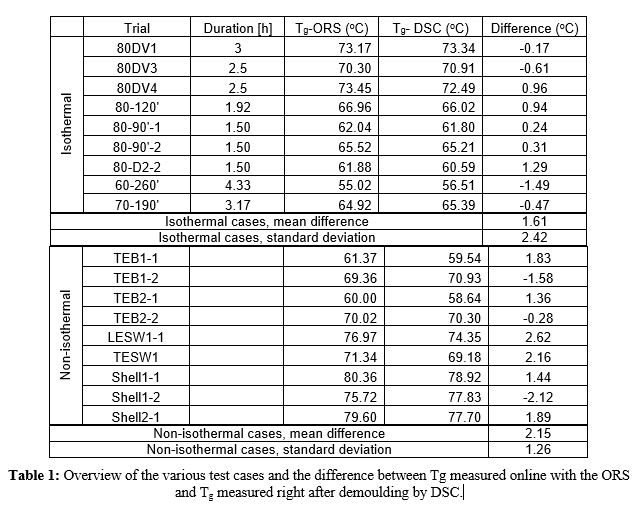We have extensively proven that the resistivity of a reactive resin is directly related to its viscosity when the resin is liquid while after gelation, the resistivity is correlated to the Glass transition Temperature (Tg) of the solid resin. Hence, the build-up of the Glass Transition temperature (Tg) during curing can be estimated online using the measurements from resistance and temperature. The involvement of temperature is absolutely necessary since resistivity is affected also by the temperature of the resin.
Based on this behaviour, Synthesites developed proprietary software which relies on the Optimold measurements and is capable to provide accurately the Tg online at DSC or DMA accuracy as can be seen in the tables below. The Online Resin State (ORS) module has been developed for a range of thermoset resins and reactive thermoplastic resins. The ORS module was initially developed for isothermal cases but now has been further extended to deal with highly non-isothermal conditions i.e. high exotherms with long cooling stages or slow heating processes such as those found in adhesive bonding in wind turbine blades. The ORS software can run independently for each cure sensor while the online estimated Tg can be used for quality control purposes as well as for actively controlling the curing stage of the whole structure. Finally, a signal can be automatically transferred to the temperature control unit or PLC to stop heating and potentially to cool down. In this way, a considerable speed-up of the curing cycle can be achieved when a specific and fully reproducible Tg level can be ensured independently of the external conditions.
This is a feature that has been demonstrated only by Synthesites in various applications, provides a unique tool to composites manufacturers for the online Tg estimation to stop heating well before the fixed curing cycle, saving time and energy, ensuring the (minimum) Tg of the product.

Another unique feature of this technology is the ability to adapt the online estimation to the techniques and standards of the specific user. In this way, we can avoid any incompatibilities on measuring devices and standards and our software can provide an estimation of the accuracy of the calibration values whether these are measured by DSC or by DMA or any other method.
For example in the table below for an aerospace application where the Tg was measured by DMA, the comparison between the online Tg values provided by ORS are within good accuracy to the Tg values that were measured afterward with the DMA equipment.

You might also be interested in:



